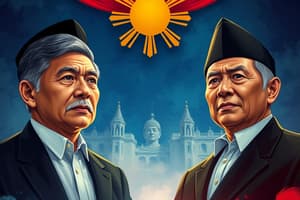Podcast
Questions and Answers
The 13th President of the Philippines, Joseph Ejercito Estrada, was born on ______.
The 13th President of the Philippines, Joseph Ejercito Estrada, was born on ______.
April 19, 1937
Maria Gloria Macaraeg Macapagal-Arroyo, the 14th President, was born in ______.
Maria Gloria Macaraeg Macapagal-Arroyo, the 14th President, was born in ______.
San Juan, Rizal
The 15th President, Benigno Simeon Cojuanco Aquino III, was also known as ______.
The 15th President, Benigno Simeon Cojuanco Aquino III, was also known as ______.
Noynoy
Rodrigo Roa Duterte, the 16th President, was born in ______.
Rodrigo Roa Duterte, the 16th President, was born in ______.
The 17th President of the Philippines is Ferdinand Romualdez Marcos Jr., commonly referred to as ______.
The 17th President of the Philippines is Ferdinand Romualdez Marcos Jr., commonly referred to as ______.
Joseph Ejercito Estrada established the National ______ Commission.
Joseph Ejercito Estrada established the National ______ Commission.
The 14th President implemented the Expanded Value Added ______.
The 14th President implemented the Expanded Value Added ______.
Benigno Aquino III negotiated a peace agreement with the Moro Islamic ______ Front.
Benigno Aquino III negotiated a peace agreement with the Moro Islamic ______ Front.
Diosdado Pangan Macapagal Sr. was born on September 28, 1910 in ______, Philippines.
Diosdado Pangan Macapagal Sr. was born on September 28, 1910 in ______, Philippines.
Ferdinand Emmanuel Edralin Marcos Sr. imposed ______ law in 1972.
Ferdinand Emmanuel Edralin Marcos Sr. imposed ______ law in 1972.
Maria Corazon Sumulong Cojuangco Aquino was the first ______ president of the Philippines.
Maria Corazon Sumulong Cojuangco Aquino was the first ______ president of the Philippines.
Fidel Valdez Ramos is known as ______ or Eddie.
Fidel Valdez Ramos is known as ______ or Eddie.
Diosdado Macapagal introduced the country’s first land reform ______.
Diosdado Macapagal introduced the country’s first land reform ______.
Maria Corazon Aquino led the ______ Power Revolution in February 1986.
Maria Corazon Aquino led the ______ Power Revolution in February 1986.
Ferdinand Marcos built the ______ Center of the Philippines complex.
Ferdinand Marcos built the ______ Center of the Philippines complex.
Fidel Ramos was the first ______ president of the Philippines.
Fidel Ramos was the first ______ president of the Philippines.
Flashcards
9th President of the Philippines
9th President of the Philippines
Diosdado Macapagal, introduced land reform, shifted peso to free market, and liberalized foreign exchange.
10th President of the Philippines
10th President of the Philippines
Ferdinand Marcos Sr., known for imposing martial law and large-scale infrastructure projects, but also for borrowing heavily.
11th President of the Philippines
11th President of the Philippines
Corazon Aquino, leading the People Power Revolution, restoring democracy, and implementing land reform.
12th President of the Philippines
12th President of the Philippines
Signup and view all the flashcards
People Power Revolution
People Power Revolution
Signup and view all the flashcards
Agricultural Land Reform Code of 1963
Agricultural Land Reform Code of 1963
Signup and view all the flashcards
Martial Law
Martial Law
Signup and view all the flashcards
Joseph Estrada's slogan
Joseph Estrada's slogan
Signup and view all the flashcards
Gloria Macapagal-Arroyo's economic initiative
Gloria Macapagal-Arroyo's economic initiative
Signup and view all the flashcards
Noynoy Aquino's economic success
Noynoy Aquino's economic success
Signup and view all the flashcards
Noynoy Aquino's peace agreement
Noynoy Aquino's peace agreement
Signup and view all the flashcards
Rodrigo Duterte's campaign
Rodrigo Duterte's campaign
Signup and view all the flashcards
Ferdinand Marcos Jr.s major act
Ferdinand Marcos Jr.s major act
Signup and view all the flashcards
Pilipinas 2000
Pilipinas 2000
Signup and view all the flashcards
13th President
13th President
Signup and view all the flashcards
14th President
14th President
Signup and view all the flashcards
15th President
15th President
Signup and view all the flashcards
16th President
16th President
Signup and view all the flashcards
17th President
17th President
Signup and view all the flashcards
Study Notes
Philippine Presidents (9-17)
-
Diosdado Macapagal:
- Introduced first land reform law
- Moved peso to free exchange market
- Liberalized foreign exchange and imports
- Changed Philippine Independence Day from July 4th to June 12th.
- Implemented Agricultural Land Reform Code of 1963.
-
Ferdinand Marcos:
- Signed Presidential Decree No. 633 (first national women's machinery)
- Imposed martial law in 1972
- Developed the Cultural Center of the Philippines, San Juanico Bridge, Philippine International Convention Center, and the Philippine Heart Center.
- Utilized foreign loans for projects
-
Corazon Aquino:
- Led the People Power Revolution in 1986, removing Marcos from power
- First female president
- Restored democracy
- Introduced the Comprehensive Agrarian Reform Program (CARP)
- Established the Commission on Human Rights
- Advocated for women's rights
-
Fidel Ramos:
- First Protestant president
- First Christian Democrat elected
- Instrumental in the Second EDSA Revolution, removing Joseph Estrada.
- Implemented Pilipinas 2000, Special Economic Zones (SEZs), National Unification Commission (NUC), Oplan Alis Disease
-
Joseph Estrada:
- Chaired the Presidential Anti-Crime Commission (PACC)
- Ran for president in 1998 with the slogan "Erap Para Sa Mahirap" (Erap for the Poor)
- Established the National Anti-Poverty Commission
- Promoted the Comprehensive Agrarian Reform Program (CARP)
- Supported the Rice Sufficiency Program
-
Gloria Macapagal-Arroyo:
- Implemented the Expanded Value Added Tax (EVAT)
- Created the Pantawid Pamilyang Pilipino Program (4Ps)
- Achieved over 7% annual economic growth by the end of her term
-
Benigno Aquino III:
- Experienced significant economic growth, earning the Philippines the title of a "Rising Tiger" economy.
- Negotiated peace agreement with the Moro Islamic Liberation Front (MILF), promising autonomy in Southern Mindanao.
- Led anti-corruption efforts, filing cases against corrupt officials, including former President Gloria Macapagal-Arroyo.
-
Rodrigo Duterte:
- Implemented a "War on Drugs"
- Supported the "Build! Build! Build!" Program (infrastructure investment)
- Spearheaded the ratification or other implementation of Train Act of 1997
-
Ferdinand Marcos Jr.:
- Signed the Maharlika Investment Fund (RA No. 11954)
Studying That Suits You
Use AI to generate personalized quizzes and flashcards to suit your learning preferences.




